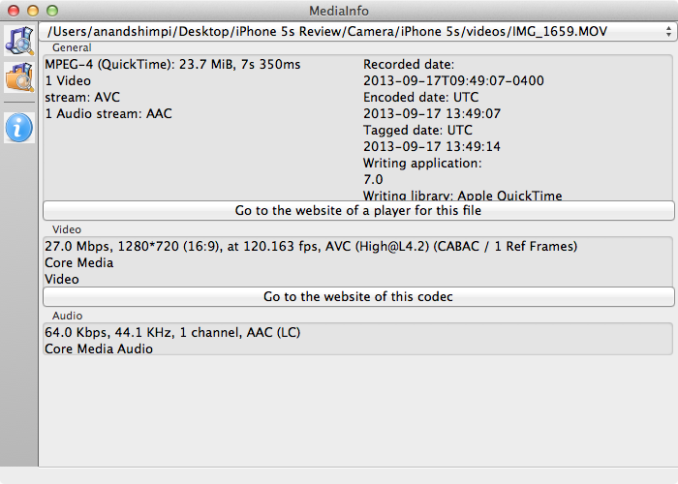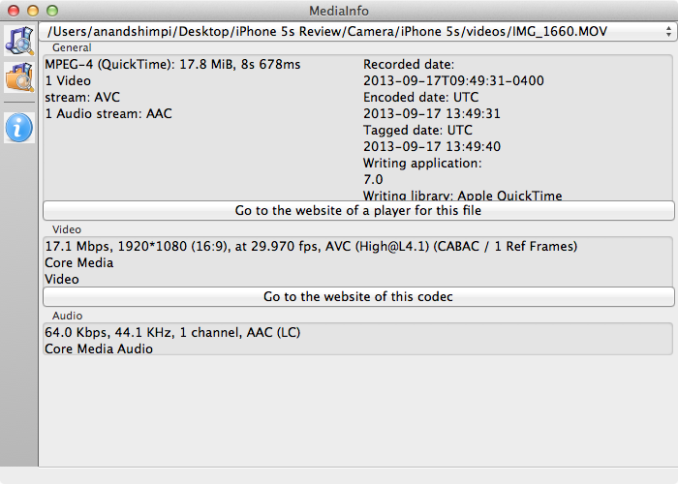The iPhone 5s Review
by Anand Lal Shimpi on September 17, 2013 9:01 PM EST- Posted in
- Smartphones
- Apple
- Mobile
- iPhone
- iPhone 5S
Video
Apple’s new H6 ISP brings with it a modernization of the video recording options for the iPhone 5s. The default video record mode is still 1080p at 30 fps, but there’s also a new 720p 120 fps “slo-mo” mode as well. In the latter, video is captured at 120 fps but optionally played back at 30 fps in order to achieve a high speed camera/slow motion effect. The result is pretty cool:
In the camera UI you can select what portions of the video you want to play back at 30 fps and what portions you want to leave at full speed. The .mov file is stored on NAND as a ~27Mbps 720p120 without any customizations, however when you share it the entire video is transcoded into a 30 fps format which preserves the slow motion effect.
The slo-mo mode is separate from the standard video recording mode, it’s the next stop on the dial in the new iOS 7 camera app. Video preview in slo-mo mode also happens at 60 fps compared to 30 fps for the standard video record and still image capture modes.
 Camera preview frame rate, toggling between slo-mo and normal modes
Camera preview frame rate, toggling between slo-mo and normal modes
Adding high speed camera modes to smartphones is a great step in my opinion and a wonderful use of increases in ISP and SoC performance. I would like to see Apple expose a 1080p60 mode as well. Technically 1080p60 does require slightly more bandwidth than 720p120, but I’d hope that Apple targeted both in the design of H6 and simply chose to expose 720p120 as it’s an easier feature to market.
Standard 1080p30 recording is also available:













464 Comments
View All Comments
solipsism - Wednesday, September 18, 2013 - link
There is definitely additional space required for both 2x images and iPad 1x and 2x images when making an app Universal.akdj - Wednesday, October 9, 2013 - link
I think Apple is NOW mandating retina assets only, isn't that something that came up with the iOS7/XCode 5 updates? (Essentially ensuring an iPad mini 'retina' and the gradual phasing out of the first two iPads....or, is it possible they can 'halve' the resolution just as they do the 2x for iPhone apps on iPads?)tipoo - Tuesday, September 17, 2013 - link
When you say mobile Core 2 class performance, does that mean Core 2 ULVs like in the Macbook Air a few generations back, or Core 2 proper? I can't find any comparisons directly from Bay Trail to Core 2.Krysto - Wednesday, September 18, 2013 - link
Since he said MBA, then ULV.Anand Lal Shimpi - Wednesday, September 18, 2013 - link
Core 2 ULVstipoo - Tuesday, September 17, 2013 - link
Is there supposed to be a 5S in the Basemark X off screen?http://images.anandtech.com/graphs/graph7335/58164...
dylan522p - Tuesday, September 17, 2013 - link
He mentioned he ran into a bug.tipoo - Tuesday, September 17, 2013 - link
is the RAM use of these 64 bit apps higher than the 32 bit ones running on the 5? On x86 at least, moving to 64 bit pointers usually bloats your program about 25%Ryan Smith - Tuesday, September 17, 2013 - link
Yes, RAM usage will be higher to some degree. Apple's own 64-bit guide makes brief mention of it, noting that it needs to be suitably managed to avoid a performance regression.https://developer.apple.com/library/prerelease/ios...
Eug - Wednesday, September 18, 2013 - link
I knew this 5S wasn't "just" another S iteration. I figured this machine was going to be a beast in terms of performance, and the improved camera, as well as the fingerprint scanner make this purchase a no-brainer for me.Except for one thing...
Given the potentially somewhat increased memory usage going to 64-bit, I was disappointed that this machine didn't get 2 GB RAM. 64-bit future-proofs the iPhone 5S such that it is IMHO likely to last one generation longer for iOS updates vs. the iPhone 5/5C. The problem though is by that time (2016?) the 1 GB RAM would likely be pretty limiting.
But then I wonder if even in 2013-2014 it could be somewhat limiting too, even just compared to the 5/5C which would have apps with smaller memory footprints using that same 1 GB amount of RAM.